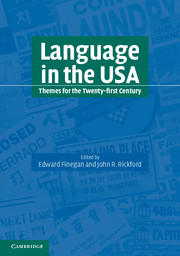Book contents
- Frontmatter
- Contents
- List of figures
- List of tables
- List of contributors
- Acknowledgments
- Foreword
- Editors' preface
- Part 1 American English
- 1 American English: its origins and history
- 2 American English and its distinctiveness
- 3 Regional dialects
- 4 Social varieties of American English
- 5 African American English
- 6 The Dictionary of American Regional English
- Part 2 Other language varieties
- Part 3 The sociolinguistic situation
- Index
5 - African American English
Published online by Cambridge University Press: 05 June 2012
- Frontmatter
- Contents
- List of figures
- List of tables
- List of contributors
- Acknowledgments
- Foreword
- Editors' preface
- Part 1 American English
- 1 American English: its origins and history
- 2 American English and its distinctiveness
- 3 Regional dialects
- 4 Social varieties of American English
- 5 African American English
- 6 The Dictionary of American Regional English
- Part 2 Other language varieties
- Part 3 The sociolinguistic situation
- Index
Summary
Editors' introduction
This chapter explores the nature of African American English, the single-most studied American English variety over the past three decades, and one that has also been at the center of public controversies involving education. Lisa Green begins by commenting on the profusion of labels this variety has attracted over the years, including “Negro Dialect,” “Black Communications,” and “African American Language” in addition to the “African American English” designation (AAE) she favors. While these terms vary to some extent according to changing social climates and ideologies, the point she emphasizes is that AAE is a linguistic system, with well-defined rules.
After a brief overview of alternative views about the origins of AAE (including the Substratist, Creolist, Anglicist, Founder principle, and Settler principle views), the chapter focuses on its present-day characteristics. While its vocabulary does include current slang (e.g., off the chain ‘good, exciting, outstanding’), familiar mainly to preadolescents and young adults, it also includes general vocabulary known by AAE speakers of all age groups (e.g., saditty ‘conceited, uppity’), and verbal markers like invariant be for a habitual or recurrent activity. Using a single complex sentence, Didn't nobody ask me do I be late for class (‘Nobody asked me if I am usually late for class’), the chapter illustrates characteristic AAE syntactic features like negative inversion, multiple negation, and the formation of embedded yes/no questions.
Under “Sound patterns,” this chapter discusses the restrictions on the occurrences of consonant clusters like -ld and -st (as in wild west) and the alternative realizations of English “th” as /t/, /d/, /f/, or /v/ in AAE. In each case, the processes are not haphazard but systematic and rule-governed.
- Type
- Chapter
- Information
- Language in the USAThemes for the Twenty-first Century, pp. 76 - 91Publisher: Cambridge University PressPrint publication year: 2004
- 10
- Cited by



